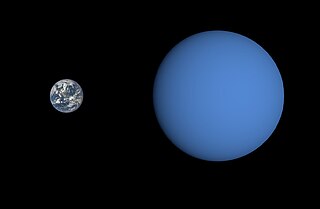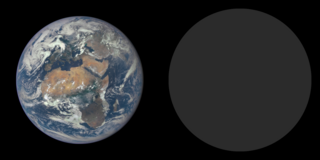
HD 219134 is a main-sequence star in the constellation of Cassiopeia. It is smaller and less luminous than the Sun, with a spectral class of K3V, which makes it an orange-hued star. HD 219134 is relatively close to our system, with an estimated distance of 21.34 light years. This star is close to the limit of apparent magnitude that can still be seen by the unaided eye. The limit is considered to be magnitude 6 for most observers. This star has a magnitude 9.4 optical companion at an angular separation of 106.6 arcseconds.

55 Cancri e is an exoplanet orbiting a Sun-like host star, 55 Cancri A. The mass of the exoplanet is about eight Earth masses and its diameter is about twice that of the Earth. 55 Cancri e was discovered on 30 August 2004, thus making it the first super-Earth discovered around a main sequence star, predating Gliese 876 d by a year. It is the innermost planet in its planetary system, taking less than 18 hours to complete an orbit. However, until the 2010 observations and recalculations, this planet had been thought to take about 2.8 days to orbit the star.

GJ 1214 b is an exoplanet that orbits the star GJ 1214, and was discovered in December 2009. Its parent star is 48 light-years from the Sun, in the constellation Ophiuchus. As of 2017, GJ 1214 b is the most likely known candidate for being an ocean planet. For that reason, scientists often call the planet a "waterworld".

WASP-43b, formally named Astrolábos, is a transiting planet in orbit around the young, active, and low-mass star WASP-43 in the constellation Sextans. The planet is a hot Jupiter with a mass twice that of Jupiter, but with a roughly equal radius. WASP-43b was flagged as a candidate by the SuperWASP program, before they conducted follow-ups using instruments at La Silla Observatory in Chile, which confirmed its existence and provided orbital and physical characteristics. The planet's discovery was published on April 14, 2011.

GJ 3470 b is an exoplanet orbiting the star GJ 3470, located in the constellation Cancer. With a mass of just under 14 Earth-masses, a radius approximately 4.3 times that of Earth's, and a high equilibrium temperature of 615 K, it is a hot Neptune.

TRAPPIST-1 is a cool red dwarf star with seven known exoplanets. It lies in the constellation Aquarius about 40.66 light-years away from Earth, and has a surface temperature of about 2,566 K. Its radius is slightly larger than Jupiter and it has a mass of about 9% of the Sun. It is estimated to be 7.6 billion years old, making it older than the Solar System. The discovery of the star was first published in 2000.

TRAPPIST-1b is a mainly rocky exoplanet orbiting around the ultra-cool dwarf star TRAPPIST-1, located 40.7 light-years away from Earth in the constellation of Aquarius. The planet was detected using the transit method, where a planet dims the host star's light as it passes in front of it. It was first announced on May 2, 2016, and later studies were able to refine its physical parameters.

TRAPPIST-1c, also designated as 2MASS J23062928-0502285 c, is a mainly rocky exoplanet orbiting around the ultracool dwarf star TRAPPIST-1, located 40.7 light-years away from Earth in the constellation Aquarius. It is the third most massive and third largest planet of the system, with about 131% the mass and 110% the radius of Earth. Its density indicates a primarily rocky composition, and observations by the James Webb Space Telescope announced in 2023 suggests against a thick CO2 atmosphere, however this does not exclude a thick abiotic oxygen-dominated atmosphere as is hypothesized to be common around red dwarf stars.

TRAPPIST-1h, also designated as 2MASS J23062928-0502285 h, is an exoplanet orbiting around the ultra-cool dwarf star TRAPPIST-1, located 40.7 light-years away from Earth in the constellation Aquarius. It was one of four new exoplanets to be discovered orbiting the star in 2017 using observations from the Spitzer Space Telescope. In the following years, more studies were able to refine its physical parameters.

LHS 1140 is a red dwarf in the constellation of Cetus. Based on stellar parallax measurement, it is 48.8 light-years away from the Sun. 'LHS' refers to the Luyten Half-Second Catalogue of stars with proper motions exceeding half a second of arc annually. The star is over 5 billion years old and has only about 18% the mass of the Sun and 21% of its radius. LHS 1140's rotational period is 130 days. No flares have been observed.
GJ 9827 is a star in the constellation of Pisces. It is a K-type main-sequence star with an apparent magnitude of 10.250. It is 97 light-years away, based on parallax.
WASP-79b, also known as Pollera, is an extrasolar planet orbiting the star WASP-79(Montuno). This planet is in the constellation Eridanus, and is about 810 light-years from Earth.
GJ 1132 is a small red dwarf star 41.1 light-years away from Earth in the constellation Vela. In 2015, it was revealed to have a hot rocky Earth-sized planet orbiting it every 1.6 days. In 2018, a second planet and a potential third were revealed.

LTT 1445 is a triple M-dwarf system 22.4 light-years distant in the constellation Eridanus. The primary LTT 1445 A hosts two exoplanets—one discovered in 2019 that transits the star every 5.36 days, and another found in 2021 that transits the star every 3.12 days, close to a 12:7 resonance. As of October 2022 it is the second closest transiting exoplanet system discovered, with the closest being HD 219134 bc.

Gliese 486, also known as Wolf 437 and formally named Gar, is a red dwarf star 26.4 light-years away in the constellation Virgo. It hosts one known exoplanet.
L 98-59 is a bright M dwarf star, located in the constellation of Volans, at a distance of 10.608 parsecs, as measured by the Gaia spacecraft.
















